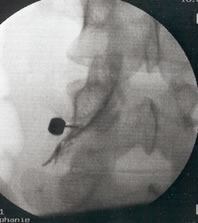
Epidural Steroid Injections
Performed by the award winning doctors in Raleigh, North Carolina

The first epidural injection was performed in 1885 by a neurologist named James Leonard Corning. Though this seminal procedure utilized the anesthetic agent cocaine, it was not until 1901 when the injection was performed with the primary goal of providing relief from pain. During this time, two separate physicians described utilizing solutions of cocaine that they injected into the sacral hiatus. The patients of these physicians were reported to be experiencing a form of radicular pain associated with a condition known as intractable sciatica. Interestingly, by 1930 caudal injections had received strong support for their use in providing pain relief. For the most part, these injections consisted of solutions of saline and local anesthetics. It wasn’t until 1953 when the use of corticosteroids in these injections began.
Epidural Steroid Injections are generally non-to minimally invasive and are conservative in nature.
Use the form on the right to request a call from our Patient Concierge Group.
Give us a call today at (919) 787-7246.[/color-box]
Anatomy of the Spine

Vertebrae: The vertebral column is the structure that is primarily referred to when talking about the spine or the backbone. The vertebral column can be found in the dorsal region of the torso. In humans, there are 24 individual vertebrae and nine fused vertebrae that make up the vertebral column. These vertebrae are made of boney tissue, containing the centrum, and a number of arches protruding from the centrum.
Spinal column: The spinal column can be divided up into several different regions. Starting at the bottom, the sacral curve is made up of four coccygeal vertebrae that form the tailbone and the sacrum. Above the sacral curve is the lumbar curve that is made up of the next five vertebrae that form the lower back, or the lumbar region. Then it is the thoracic curve that contains 12 individual vertebrae and forms the middle to upper back region. Finally, at the top is the cervical curve that creates the neck region.
Spinal cord: The spinal cord can be found within the spinal column. It is a long bundle of nerves that transfers information to and from the brain. The spinal cord begins in the top of the spinal column, at the occipital bone, and runs down through the space between the first and second lumbar. Its primary functions are to transfer motor information, control motor movements, conduit sensory information, and control some reflexes. The spinal cord is a crucial part of the human anatomy; therefore, it is well protected by both the spinal column as well as various layers of tissue known as the spinal meninges.
Benefits of Epidural Steroid Injections
For many medical procedures the efficacy of the treatment is based on a number of factors. This is also true for epidural steroid injections. Factors such as the physician’s expertise and training, duration of the symptoms, or the underlying cause of symptoms can all impact the effectiveness of the procedure and the patient’s prognosis in terms of their pain condition. In general, studies have indicated that patients who report the highest response rate to the epidural injection are patients who have been experiencing symptoms for less than three months.
The goal of epidural steroid injections is pain relief. The primary benefit of this intervention is that it is quick and relatively painless. The procedure can even be performed on an outpatient basis, making epidural steroid injections the ideal alternative to surgery for the relief of many different pain conditions, including acute and chronic conditions. Further, in addition to providing patients with relief from the distressing symptoms of pain, treatment interventions are focused on reducing the level of impairment pain has on the patient’s life, as well as any accompanying disability. For instance, for patients who have had to take a leave of absence from their job owing to their pain, it is likely that a goal of treatment will be to have the patient return to work. Reaching the status of disability can be an exacerbating factor, by acting like a feedback loop. If an individual, debilitated by severe and chronic pain, does not make efforts to maintain some mobility they are risk for maintaining their own symptoms of pain.

